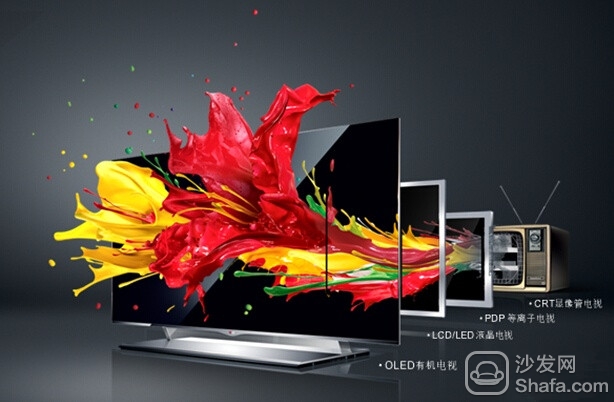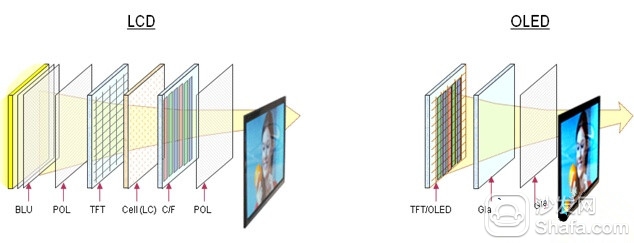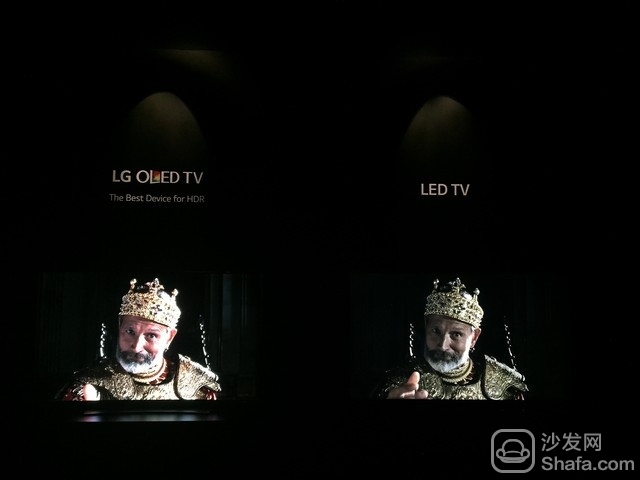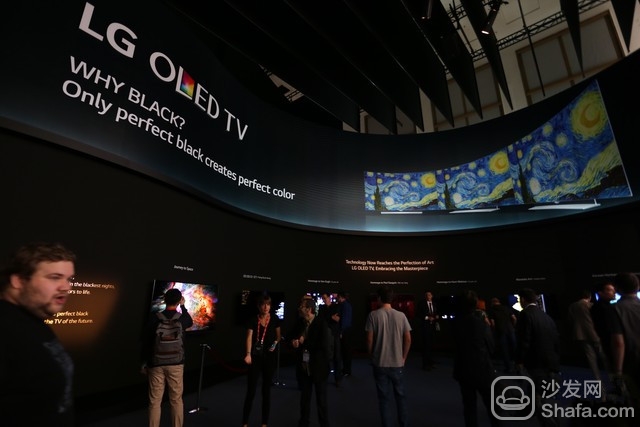We obtain most of the information through sight and hearing. Compared with the ear, human eyes are more difficult to satisfy. So TVs, monitors and other products have enough momentum to constantly update and strive to let us see the screen content infinitely close to the real world. It took nearly a hundred years from the appearance of the kinescope to being eliminated, followed by plasma and LCD technology. Now, we have ushered in a new generation of display panel technology: OLED. Compared with the LCD technology's compromise in size, price and picture quality, OLED has achieved a total surpass in the display principle, becoming the most dazzling display technology star in the market.

In 2004, flat-panel TVs (when LCDs and plasmas started at the time, and after the plasma declining, LCDs were the only big ones), the large-scale replacement of CRT TVs was the first display of technological innovation. At the time, the best Sony Ting CRT CRT TVs even surpassed the LCD TVs in some aspects of the picture quality. However, due to the fact that flat-panel TVs can be made light and thin, they eventually surpassed CRT CRT TVs to become TVs. Mainstream products.
In the past 10 years, with the continuous progress of liquid crystal display technology, full-HD, ultra-high-definition, ultra-thin, 3D, borderless and other functional genres have emerged and their image quality has become more and more realistic. However, technological innovation is still limited. When the development of a technology cannot meet the needs of consumers, it will always bring about the emergence of another innovative product.
LCD technology requires backlight, liquid crystal deflection and color filter to combine the basic principles of the picture will not change, even if the picture quality to achieve 4K, 8K ultra-high-definition, the appearance of ultra-thin, curved surface, but it is difficult to move on new Steps. Gradually mature OLEDs adopt the principle of active light emission to fundamentally solve the technical problems that have plagued LCD for many years, and have begun to pursue the perfect quality and appearance from a new height.
Why OLED is better than LCD
In a rough analogy, we can think of the LCD panel as a dazzling glass-wall building in the center of the city. The lights that we see in the windows of the building turn on the lights to make up what we see. But the lights in this building are only white, and they can't be adjusted. The brightness of each window is controlled by a louver curtain - some light up when it is turned on and dark when it is closed. The color of the window light is determined by the color of the film on the glass. As long as there are enough windows, and we can accurately control the opening and closing of blinds, we can make this building display any picture.

The display principle of the OLED building is not the same. Its lighting system itself is the window of the exterior wall, can make the window of different colored light to form the picture directly, no longer need film and curtain. The result of this is that the building displays can achieve faster and more accurate light and dark changes, and colored lights can also be more accurate and accurate than white light and film.
The difference in the display principle makes OLED panels have a great advantage in terms of picture quality compared to LCD panels. From the contrast, color, response speed and perspective, OLED's key parameters are all better, which can achieve a full upgrade in the visual experience, which has also become the common recognition trend of the large-screen display industry. At the just-concluded 2015 Consumer Electronics Show in Berlin, almost all manufacturers of TVs exhibited OLED products as their most important flagship products. Well-known brands in South Korea, Japan, and China, without exception, proved this very well. trend.
Innate technological advantages allow OLED to win at the starting line
The biggest problem with the "LCD Tower" is that the windows cannot be illuminated. It uses bulbs that are several orders of magnitude larger than windows. They can only place the light source components away from the windows or even on the side of the building, and try to use as much light as possible in a complex way. Distribute evenly to each window.
Focusing on backlighting requires a complex light path design to refract the light evenly, which is a challenge in terms of cost, thickness, and efficiency. Secondly, to realize color display, white light must pass through the color filter, which will make it difficult to improve the color performance of the LCD panel, and the color filter performance will also become a bottleneck for color performance.

More importantly, the constant backlight needs to be accurately blocked to display the brightness, darkness, and color of the image. This requires that the deflection of the liquid crystal molecules can be accurately and quickly controlled. Their light-blocking ability and conversion speed are in contrast to the image and can be viewed. The angle has an important influence.
The unique LCD display principle can only gradually improve the picture quality, but some thresholds cannot always be crossed. OLEDs are completely different. Each pixel of the OLED can precisely control the luminous intensity and timing and win directly at the starting line.

Extremely high contrast is the basis of OLED vivid and vivid images. Each pixel of the OLED can precisely control the brightness, which makes the dark part of the OLED picture perform very well, even to almost pure black. In the current practical display technology, the pure black performance of OLED is a unique skill, and even the picture tube at the peak can hardly do this. Being able to show true black is very important for high-quality picture reproduction. We can really feel the impact of high-contrast picture in the dark movie theater. If the same picture is played on a LCD TV, since the backlight cannot be completely blocked, there will inevitably be a faint light in the darkest part of the picture. This is the "original sin" of LCD.
The greatly simplified structure allows OLEDs to be extremely flexible. Since no backlight source and light guide assembly are required, OLEDs can easily achieve millimeter-level panel thickness. Compared with the structure of the LCD panel with seven or eight layers, the OLED panel basically only needs to display and frame two components. If printed on a flexible surface, it is even possible to produce an arbitrarily curved display device. Skyworth's president Yang Dongwen once said that the future of display technology lies in the ability to produce products that can be used for a wide range of applications. The OLED is a flexible technology that can fully meet the needs of hundreds of inch giant screen TV to a two-inch watch screen, not to mention the new field applications such as two-sided display, flexible curl screen LCD can not be achieved.
OLED actual viewing effect: stunning
From the appearance of OLED TV products three or four years ago, I was highly concerned about the performance of such new products. The first time we actually watched OLED TVs close to consumer products at CES, their vivid color performance and extremely high contrast gave me a deep impression.

Then every year at the large-scale exhibition can see the obvious progress of OLED TV. Their color levels are increasingly enriched on the basis of high saturation, and contrast and brightness are also increasing every year. Until the recent IFA show, I see the OLED TV show basically reached the ultimate effect of the display device's comprehensive effect: high contrast, high-resolution vivid colors that are not affected by ambient light.
Looking at a TV displaying all black content in a purely dark environment, you can barely observe the presence of OLED TVs. LCD TVs of the same size will display a faint gray screen on the wall. The difference in contrast between OLED and LCD TVs is expected. That is knowledge. In bright light, OLEDs use high-brightness and high-saturation color performance, which also allows users to easily distinguish the difference in display performance with LCD products. The high-contrast panel can provide a very vivid picture. The rich layers can accurately convey the beauty of high-quality pictures. This gives the user more visual satisfaction when watching movies and high-quality documentaries.
For the ultimate large-screen display, the most advanced projection equipment may provide better performance in a strict environment. But that is not our real life needs, and the price is far from being affordable to the average rich. But now, the price-friendly OLED is already waving to us.
Full-lead OLED is unstoppable
As the industry's promising next-generation display technology, large-size OLED panels have begun to enter the consumer-grade application market. In the past two or three years, we have seen new breakthroughs in OLED display technology in terms of cost and mass production capabilities, and we are expected to gradually begin to popularize high-end products. In fact, almost all TV brands have already launched market-oriented OLED TV products. Domestic manufacturers including Skyworth and Konka have also actively entered the market by purchasing OLED panels from upstream manufacturers. At the 2015 IFA show, TV leading manufacturers collectively adopted OLEDs. As the main product display, it fully proves the trend of the TV industry: The era of high-resolution, high-definition 4K OLEDs has already begun.
As mentioned earlier, OLEDs use completely different manufacturing methods than liquid crystals, and can achieve physical characteristics that are difficult to achieve with flexible, transparent, and ultra-thin liquid crystals. The unquestionable trend is that the cost of information processing and communications is getting lower and lower, and our demand for display capabilities will surely continue to increase, and OLEDs will have a wider range of applications. Window glass, mirrors and even any surface can be turned into display devices with OLEDs. Now that our e-reading is still limited to glass-based displays, it will not be too surprising that papers and magazines with paper-like foldable OLEDs will appear in the future.
CRT technology has developed for nearly a hundred years and has been completely subverted by LCD TVs in the past 10 years. The rhythm of technological progress is beyond imagination. TV manufacturers have fully recognized the outstanding performance of OLEDs and started to lay out their products in mid- to high-end products. It can be expected that popular mainstream products will also popularize OLED panels, and the wave of TV display technology replacements has begun.

OLED concept changes the world
In 2004, flat-panel TVs (when LCDs and plasmas started at the time, and after the plasma declining, LCDs were the only big ones), the large-scale replacement of CRT TVs was the first display of technological innovation. At the time, the best Sony Ting CRT CRT TVs even surpassed the LCD TVs in some aspects of the picture quality. However, due to the fact that flat-panel TVs can be made light and thin, they eventually surpassed CRT CRT TVs to become TVs. Mainstream products.
In the past 10 years, with the continuous progress of liquid crystal display technology, full-HD, ultra-high-definition, ultra-thin, 3D, borderless and other functional genres have emerged and their image quality has become more and more realistic. However, technological innovation is still limited. When the development of a technology cannot meet the needs of consumers, it will always bring about the emergence of another innovative product.
LCD technology requires backlight, liquid crystal deflection and color filter to combine the basic principles of the picture will not change, even if the picture quality to achieve 4K, 8K ultra-high-definition, the appearance of ultra-thin, curved surface, but it is difficult to move on new Steps. Gradually mature OLEDs adopt the principle of active light emission to fundamentally solve the technical problems that have plagued LCD for many years, and have begun to pursue the perfect quality and appearance from a new height.
Why OLED is better than LCD
In a rough analogy, we can think of the LCD panel as a dazzling glass-wall building in the center of the city. The lights that we see in the windows of the building turn on the lights to make up what we see. But the lights in this building are only white, and they can't be adjusted. The brightness of each window is controlled by a louver curtain - some light up when it is turned on and dark when it is closed. The color of the window light is determined by the color of the film on the glass. As long as there are enough windows, and we can accurately control the opening and closing of blinds, we can make this building display any picture.

TV development route
The display principle of the OLED building is not the same. Its lighting system itself is the window of the exterior wall, can make the window of different colored light to form the picture directly, no longer need film and curtain. The result of this is that the building displays can achieve faster and more accurate light and dark changes, and colored lights can also be more accurate and accurate than white light and film.
The difference in the display principle makes OLED panels have a great advantage in terms of picture quality compared to LCD panels. From the contrast, color, response speed and perspective, OLED's key parameters are all better, which can achieve a full upgrade in the visual experience, which has also become the common recognition trend of the large-screen display industry. At the just-concluded 2015 Consumer Electronics Show in Berlin, almost all manufacturers of TVs exhibited OLED products as their most important flagship products. Well-known brands in South Korea, Japan, and China, without exception, proved this very well. trend.
Innate technological advantages allow OLED to win at the starting line
The biggest problem with the "LCD Tower" is that the windows cannot be illuminated. It uses bulbs that are several orders of magnitude larger than windows. They can only place the light source components away from the windows or even on the side of the building, and try to use as much light as possible in a complex way. Distribute evenly to each window.
Focusing on backlighting requires a complex light path design to refract the light evenly, which is a challenge in terms of cost, thickness, and efficiency. Secondly, to realize color display, white light must pass through the color filter, which will make it difficult to improve the color performance of the LCD panel, and the color filter performance will also become a bottleneck for color performance.

OLED and LCD display structure comparison
More importantly, the constant backlight needs to be accurately blocked to display the brightness, darkness, and color of the image. This requires that the deflection of the liquid crystal molecules can be accurately and quickly controlled. Their light-blocking ability and conversion speed are in contrast to the image and can be viewed. The angle has an important influence.
The unique LCD display principle can only gradually improve the picture quality, but some thresholds cannot always be crossed. OLEDs are completely different. Each pixel of the OLED can precisely control the luminous intensity and timing and win directly at the starting line.

Differences between typical OLED TVs and LED TVs
Extremely high contrast is the basis of OLED vivid and vivid images. Each pixel of the OLED can precisely control the brightness, which makes the dark part of the OLED picture perform very well, even to almost pure black. In the current practical display technology, the pure black performance of OLED is a unique skill, and even the picture tube at the peak can hardly do this. Being able to show true black is very important for high-quality picture reproduction. We can really feel the impact of high-contrast picture in the dark movie theater. If the same picture is played on a LCD TV, since the backlight cannot be completely blocked, there will inevitably be a faint light in the darkest part of the picture. This is the "original sin" of LCD.
The greatly simplified structure allows OLEDs to be extremely flexible. Since no backlight source and light guide assembly are required, OLEDs can easily achieve millimeter-level panel thickness. Compared with the structure of the LCD panel with seven or eight layers, the OLED panel basically only needs to display and frame two components. If printed on a flexible surface, it is even possible to produce an arbitrarily curved display device. Skyworth's president Yang Dongwen once said that the future of display technology lies in the ability to produce products that can be used for a wide range of applications. The OLED is a flexible technology that can fully meet the needs of hundreds of inch giant screen TV to a two-inch watch screen, not to mention the new field applications such as two-sided display, flexible curl screen LCD can not be achieved.
OLED actual viewing effect: stunning
From the appearance of OLED TV products three or four years ago, I was highly concerned about the performance of such new products. The first time we actually watched OLED TVs close to consumer products at CES, their vivid color performance and extremely high contrast gave me a deep impression.

IFA LG OLED Display Wall
Then every year at the large-scale exhibition can see the obvious progress of OLED TV. Their color levels are increasingly enriched on the basis of high saturation, and contrast and brightness are also increasing every year. Until the recent IFA show, I see the OLED TV show basically reached the ultimate effect of the display device's comprehensive effect: high contrast, high-resolution vivid colors that are not affected by ambient light.
Looking at a TV displaying all black content in a purely dark environment, you can barely observe the presence of OLED TVs. LCD TVs of the same size will display a faint gray screen on the wall. The difference in contrast between OLED and LCD TVs is expected. That is knowledge. In bright light, OLEDs use high-brightness and high-saturation color performance, which also allows users to easily distinguish the difference in display performance with LCD products. The high-contrast panel can provide a very vivid picture. The rich layers can accurately convey the beauty of high-quality pictures. This gives the user more visual satisfaction when watching movies and high-quality documentaries.
For the ultimate large-screen display, the most advanced projection equipment may provide better performance in a strict environment. But that is not our real life needs, and the price is far from being affordable to the average rich. But now, the price-friendly OLED is already waving to us.
Full-lead OLED is unstoppable
As the industry's promising next-generation display technology, large-size OLED panels have begun to enter the consumer-grade application market. In the past two or three years, we have seen new breakthroughs in OLED display technology in terms of cost and mass production capabilities, and we are expected to gradually begin to popularize high-end products. In fact, almost all TV brands have already launched market-oriented OLED TV products. Domestic manufacturers including Skyworth and Konka have also actively entered the market by purchasing OLED panels from upstream manufacturers. At the 2015 IFA show, TV leading manufacturers collectively adopted OLEDs. As the main product display, it fully proves the trend of the TV industry: The era of high-resolution, high-definition 4K OLEDs has already begun.
As mentioned earlier, OLEDs use completely different manufacturing methods than liquid crystals, and can achieve physical characteristics that are difficult to achieve with flexible, transparent, and ultra-thin liquid crystals. The unquestionable trend is that the cost of information processing and communications is getting lower and lower, and our demand for display capabilities will surely continue to increase, and OLEDs will have a wider range of applications. Window glass, mirrors and even any surface can be turned into display devices with OLEDs. Now that our e-reading is still limited to glass-based displays, it will not be too surprising that papers and magazines with paper-like foldable OLEDs will appear in the future.
CRT technology has developed for nearly a hundred years and has been completely subverted by LCD TVs in the past 10 years. The rhythm of technological progress is beyond imagination. TV manufacturers have fully recognized the outstanding performance of OLEDs and started to lay out their products in mid- to high-end products. It can be expected that popular mainstream products will also popularize OLED panels, and the wave of TV display technology replacements has begun.
We are saleing Touch Screen For Mitsubishi,provides the product information.
Touch screen for Mitsubishi are widely used for medical and industrial equipment, research shows, machinery equipment, industrial control, man-machine interface, industrial automation integrated workstation, POS, CNC etc. we have a lot of Touch Screen for Mitsubishi, standing some of our inventory stock.
Touch screen for Mitsubishi
Touch Screen For Mitsubishi,Touch Screen For Mitsubishi Replacement,Touch Panel For Mitsubishi
GUANGZHOU VICPAS TOUCH TECHNOLOGY CO.,LTD , https://www.touchsuppliers.com